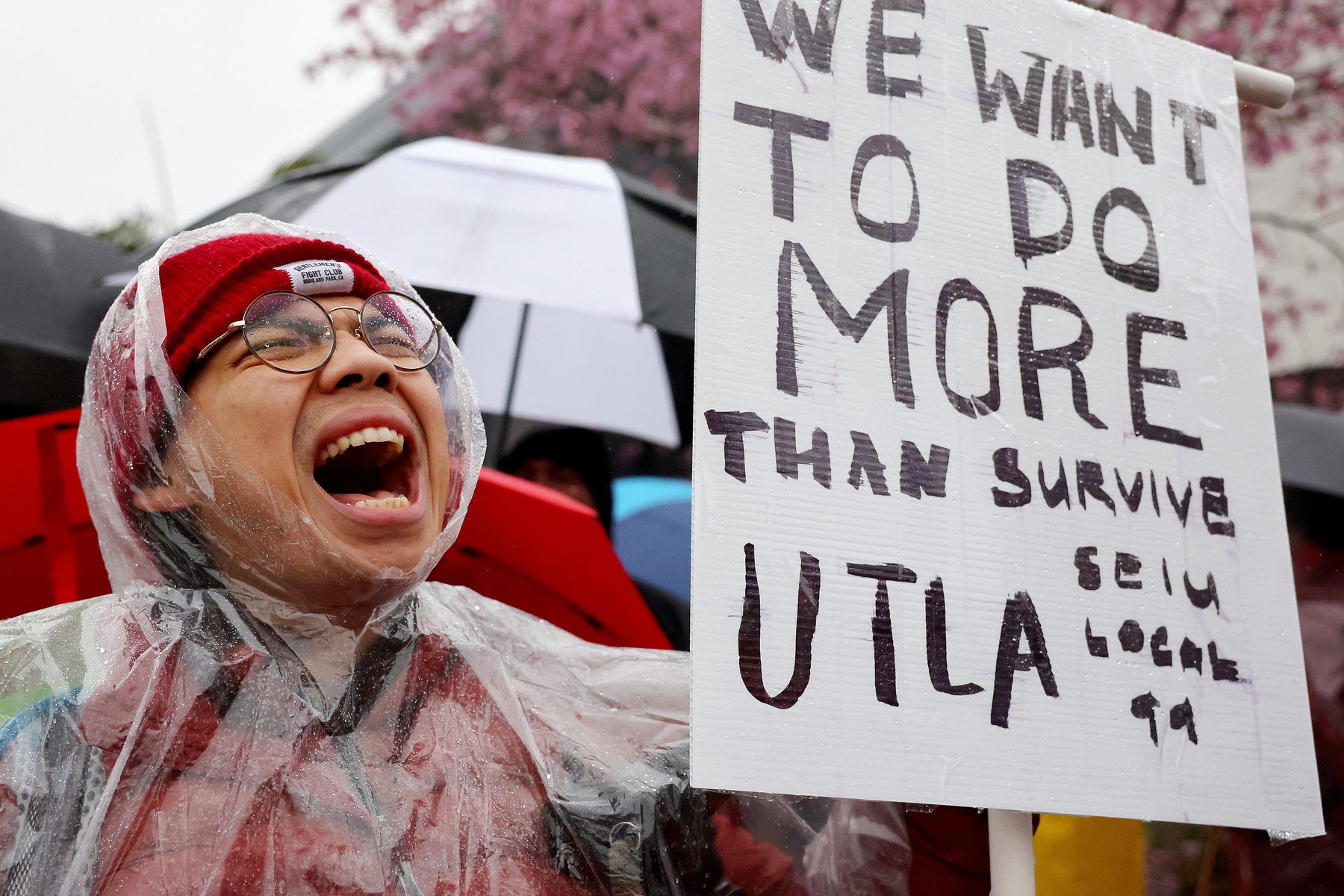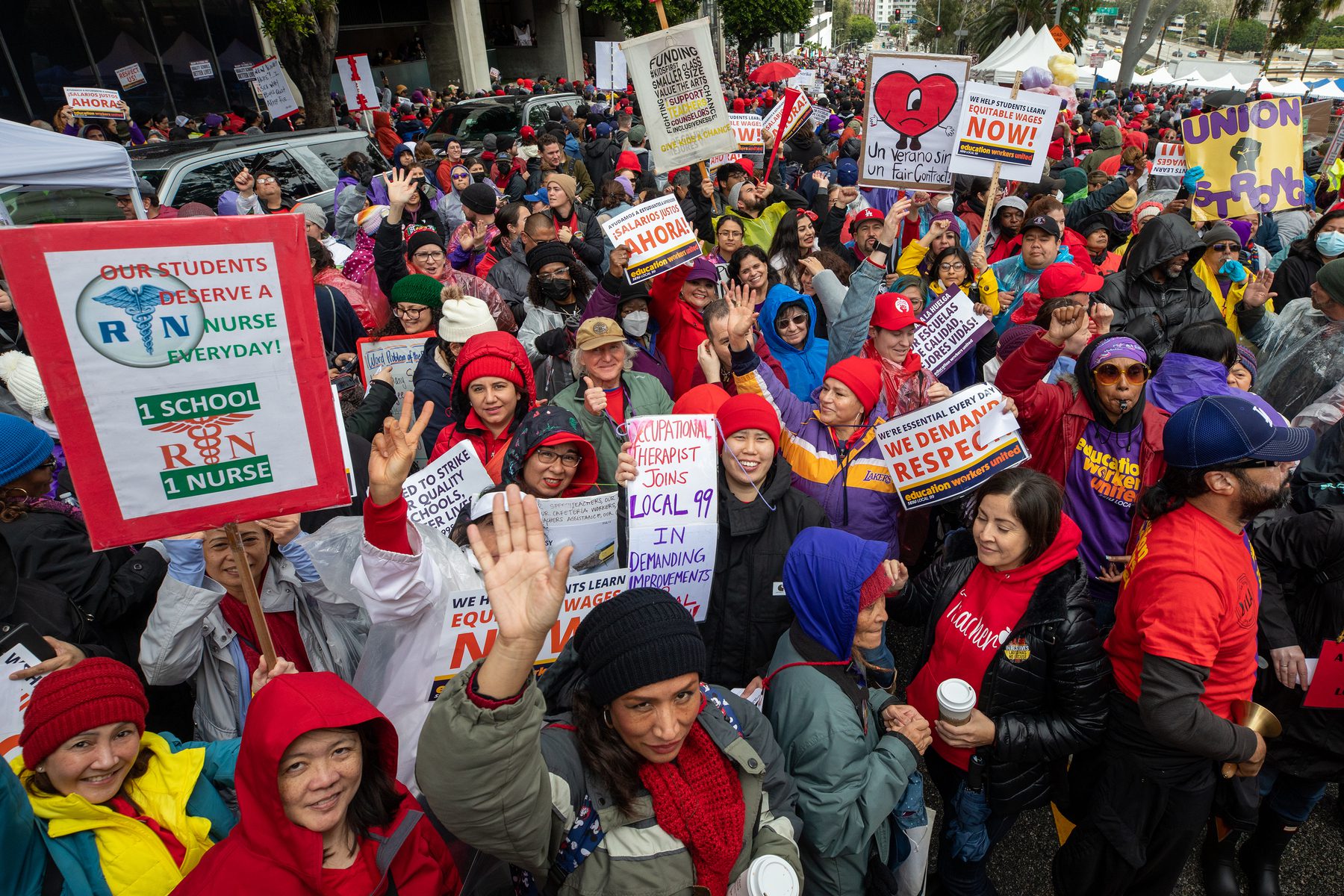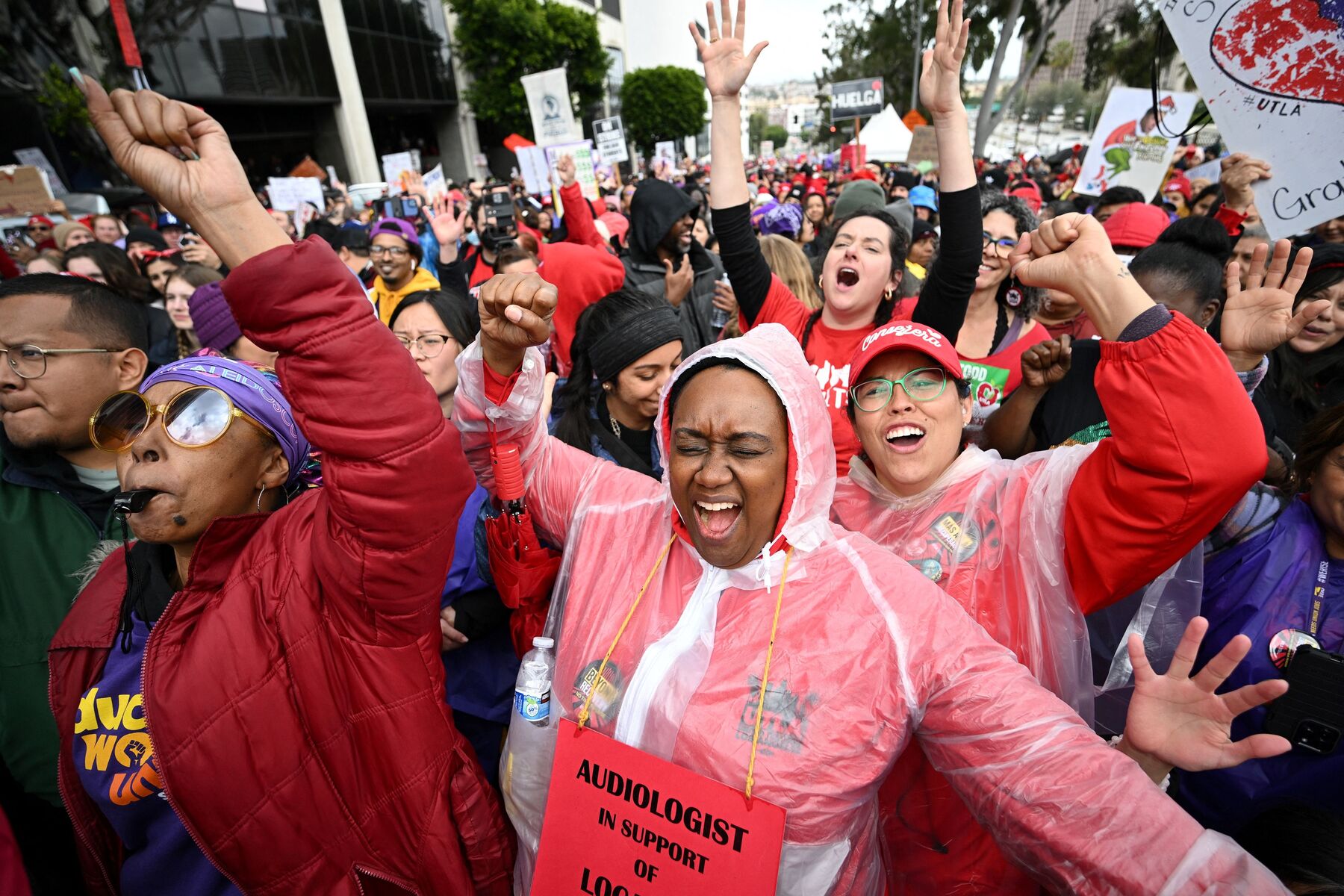We’re answering the “how” and “why” of education and politics news. Subscribe to our daily newsletter.
LOS ANGELES — At the School of Social Justice, Julia Quiroz is one of a kind: She’s the sole bilingual teaching assistant. Despite her unique role on the campus of more than 400 students — 35 percent of whom are English learners — Quiroz’s hourly pay is $16.91, not much more than California’s minimum wage of $15.50.
The income she receives from the Los Angeles Unified School District (LAUSD), where she has worked since 2016, is not enough to get by in one of the nation’s most expensive cities, she told The 19th.
“Honestly, I don’t think I would be able to make ends meet every month if I would be by myself,” she said. “Two of my siblings still live with me, so we kind of distribute the expenses among us. It’s practically three salaries together to survive.”
Quiroz is one of 30,000 LAUSD classified workers — bus drivers, cafeteria staff, paraprofessionals, etc. — participating in a three-day walkout that kicked off Tuesday as an atmospheric river bombarded Los Angeles with wind gusts and torrential rain. The 35,000 members of United Teachers Los Angeles (UTLA), which represents LAUSD teachers, are showing solidarity to the classified workers by not crossing the picket line.
The teachers’ “sympathy strike” leaves the nation’s second-largest school district with an absence of more than 65,000 workers — many of them women and people of color — forcing schools to close amid a labor action that coincides with an acute educator shortage multiple states have faced during the COVID-19 pandemic. Experts say the educator shortage has given workers in the field leverage to demand better pay and benefits as state and national lawmakers craft legislation to attract and retain school personnel.
The classified workers on strike belong to the Service Employees International Union (SEIU) Local 99 and have not had a new contract with LAUSD in more than two years, prompting them to authorize a strike in February. During the strike vote and negotiation process, however, SEIU Local 99 alleges that “the district subjected workers to surveillance, intimidation, and harassment,” a charge that allows them to legally hold a short strike in response to what they deem as unfair labor practices, without fear of punishment.
“Thirty-thousand workers standing together can’t be intimidated, bullied or underestimated,” said Max Arias, executive director of SEIU Local 99, in a statement. “Despite LAUSD’s misleading statements in the media and threats against workers who are exercising their right to take action, our movement is only growing stronger. Teachers, students and parents in the district are standing with school workers and their right to take action — free from fear — to bargain for better wages and increased staffing in our schools.”
SEIU Local 99 is demanding that the school district give its classified workers a 30 percent pay bump and a $2 per hour equity wage adjustment. UTLA is also in the middle of bargaining. Their contract with the district expired last year, and they’re asking for a 20 percent pay raise and comprehensive services for students and families. Teachers last went on strike in 2019.

Last year, education workers began strikes in small districts in states including Illinois, California, Massachusetts and Washington and major cities including Seattle, Columbus, Sacramento and Minneapolis. With school staff in Greater Boston striking last month and those in Oakland, California, and Woodburn, Oregon, reportedly contemplating doing so as the LAUSD strike begins, the movement of education workers challenging districts to improve their treatment and compensation of them persists in 2023. It has the potential, according to scholars, to produce unprecedented gains for school workers, particularly in Los Angeles, where a housing crisis has caused the cost of living to skyrocket.
“What SEIU is asking for is historic,” said Bradley D. Marianno, an assistant professor of educational policy and leadership and director of the Center for Research, Evaluation, and Assessment at the University of Nevada, Las Vegas. “The typical salary increase for these types of negotiations is 3 to 5 percent, so a 30 percent increase would be historic. UTLA is asking for a 20 percent increase, which would also be historic. I think they believe that if they make enough disruption that they can actually achieve that type of raise, and, of course, we’re living in this inflationary environment where cost of living has gone up for all of these workers, which also comes into play.”
Although such large raises would be unprecedented, they appear to be within reach of the workers. During a press conference about the strike late Monday, LAUSD Superintendent Alberto Carvalho said that the district had last offered its classified staff a recurring 23 percent raise and a 3 percent cash-in-hand bonus.
“We understand the frustration, a frustration that has been brewing, not just for a couple of years, probably for decades,” said Carvalho, who just celebrated his first year as LAUSD superintendent in February, having formerly led Miami-Dade County Public Schools in Florida for 14 years. “And it is on the basis of recognizing historic inequities, in recognizing the economic imperatives before our workforce that we began these bargaining sessions with historic proposals on the table.”
SEIU Local 99 workers, many of whom are not full-time, earn an average yearly salary of $25,000. According to the Massachusetts Institute of Technology’s living wage calculator, a single adult without children would need to earn at least $21.22 hourly to make a living wage in Los Angeles.
“The main factor is that the workers are underpaid, and we know that,” said Pedro Noguera, dean of the Rossier School of Education at the University of Southern California. “Their concerns are not unreasonable. They are very much underpaid, and we know from the pandemic they are essential. The district cannot operate without its bus drivers, without the cafeteria workers, the receptionists. They’re not the people we typically think of as being central to the district, but they are vital.”
Noguera said that the recent strikes of essential workers, educators and otherwise, taking place nationally indicate that their wages are simply too low. With a dearth of affordable housing, L.A.’s low-wage workers face particular challenges. These include spending the bulk of their earnings on housing costs, making long commutes because they can’t afford to live where they work, or residing with relatives or in their vehicles to survive, Noguera said. “This is unacceptable,” he said. “We need to take major steps to prevent homelessness among these workers who are demanding more and deserve more. The question is, ‘Where does the money come from?’”
LAUSD has been described as having “a wealth of cash” — billions in reserves — but Marianno pointed out that school districts can no longer count on the infusion of federal COVID relief funds they received when the pandemic began. Moreover, large urban school districts have faced declining enrollment that also affects their finances. Today, LAUSD has an enrollment of about 420,000 students, a steep drop from just a few years ago when it had an enrollment of over 600,000 students.
“In the state of California, where funding allocations are based on enrollment amounts, that means that the amount of state funds flowing into a district will continue to decrease over time,” Marianno said. “So, you’ve got school district budget personnel who have to project what enrollment is going to look like year-over-year and those projections can be really messy. When the actual funding allocations don’t come in at the same level as the projections, you’ve got union personnel who will essentially say that the school district is hiding parts of funds and not being fair and transparent.”
For workers like Quiroz, the pay they receive from the district does not feel fair. “We’re actually stretching every single dollar,” she said. “And I really hope that by standing unified we get the respect that we deserve.” She questions whether district officials or the public generally understands the workload and responsibilities of classified workers. She often does not have a moment to spare during her workday, as she routinely has to complete her duties and those of others due to an ongoing personnel shortage. As a bilingual teaching assistant, she is also required by the district to take professional development courses each school year that she is responsible for covering.
“So besides having a really low salary, we also have to pay for our college classes,” she said.

Even before the pandemic, Quiroz watched fellow teaching assistants leave LAUSD to work in other industries. Many landed restaurant jobs that allowed them to earn $5 more per hour than they received as paraeducators, she said. Although she has earned an associate’s degree and is currently pursuing a bachelor’s degree, she does not feel that the district recognizes her expertise and hard work.
Alicia Montes also wants to be better compensated as a classified worker. She is a campus aide at the Miguel Contreras Learning Complex, home to four different high schools in L.A.’s Westlake District. The role requires her to ensure that trespassers don’t walk onto school grounds and that students get to class safely, among other duties. Montes has worked for the district continuously since 2006, and before then as a teacher’s aide from about 1984 to 1995. Despite her years of service, the 63-year-old makes less than $30,000 annually, she said. Montes survives by splitting the cost of rent with her nephew and living frugally.
“They need to realize that — the campus aides, the [teaching assistants], cafeteria people, the building and grounds workers — we’re the ones taking care of the school,” she said of LAUSD officials. “The teachers are teaching the kids, but it’s the support staff that is here making sure that the school runs.”
Rachel Wagner, the mother of an LAUSD third-grader and a leader in the group Parents Supporting Teachers, which has 30,000 members, noted that many of the cafeteria workers feeding LAUSD students can’t afford to feed their own children — a detail she said she knows through her advocacy work and because she has researched the salaries of classified workers. In a city such as Los Angeles, $25,000 annually is a poverty wage, she said.
“It really is wrong that they are not being paid fairly,” she said. “This isn’t something that has just come about. I know that historically they’ve been grossly underpaid. And I think you reach a point where you say enough is enough.”
Marianno said the fact that teachers are engaging in a sympathy strike with the classified workers is relatively rare because such strikes are prohibited in many places. While the teachers may want to show solidarity with the classified workers, their walkout also enables them to flex their muscle as they negotiate for a salary increase with the school district, Marianno said. In the fall, UTLA released a report emphasizing that teachers receive less pay than comparably educated workers in Los Angeles and often have to take on additional work to afford to live in the city.
Noguera fears that another teacher strike could be imminent in Los Angeles. Should that happen it will “really put the new superintendent to the test,” he said. He hopes Los Angeles Mayor Karen Bass and other city leaders will intervene, but he expects educator strikes to keep taking place locally and nationally in the coming months and years.
“Our schools have been underfunded and our teachers have been underpaid,” Noguera said. “And now with the teacher shortage, they know it’s a good time to demand more, and they have a right to because being a teacher is hard, being a worker in schools is hard. It should not mean that you’re living on the verge of homelessness because you’ve chosen to work with the school district.”
Still, he worries that another strike in Los Angeles could drive parents out of a school district that is already suffering from an enrollment decline and that faced fierce criticism for continuing virtual learning for more than a year after COVID-19 forced schools to close in March 2020.
Wagner said that she understands why parents feel inconvenienced by the current strike and interruptions to their children’s schooling. She said that it’s discouraging that the district and the workers did not settle their contract dispute before tensions reached this point.
“Every year, there seems to be some type of a disruption, and it’s frustrating they [students] have lost a lot of ground, but at the end of the day, I’ll sacrifice three days of my child being in school if it’s going to give the people in school, who are working to feed him and support him, a better wage,” she said.
Nadra Nittle is married to an LAUSD teacher and UTLA member.





